Adsorptive Removal of Chemical Oxygen Demand Using Eggshells and Tea Waste Entrapped in Calcium Alginate
DOI:
https://doi.org/10.30872/j.trop.pharm.chem.v7i2.153Keywords:
Agriculture waste, Biosorption, Wastewater, Calcium alginateAbstract
This study aims to assess the efficiency of two agricultural wastes as biosorbents to remove the chemical oxygen demand (COD) from a batik wastewater sample. COD-containing batik wastewater was treated with a combination of biosorbents by eggshells and tea waste activated using H?SO? and then immobilized in calcium alginate through the entrapment technique. The contact time, pH, and biosorbent dose were all investigated to examine the efficiency of biosorbent to remove COD. The independent variables for the optimization process are the contact time (47.13, 50, 60, 70, and 72.87 min), pH of the samples (1.71, 2,3, 4, and 4.28), and the ratio of the number of biosorbent between eggshells: tea waste (2.67:12.33, 3.75:11.25, 7.5:7.5, 11.25:3.75, and 12.33:2.67). The Characterization of the biosorbents was investigated using scanning electron microscopy (SEM), Fourier transforms infrared spectroscopy (FTIR), and energy-dispersive x-ray (EDX) analysis. The results show that eggshells and tea waste immobilized by calcium alginate with a ratio of 2.67 g: 12.33 g, a contact time of 60 min, and a sample pH of 3 are 89% effective in removing the COD in batik wastewater samples.
Downloads
References
Probosiwi and F. Vais, Buku Panduan Menggambar Motif Batik di Jawa. 2021.
A. P. Siregar et al., “Upaya Pengembangan Industri Batik Di Indonesia,” Din. Kerajinan dan Batik Maj. Ilm., vol. 37, no. 1, pp. 41–54, 2020, doi: 10.22322/dkb.V36i1.4149.
D. Y. Purwaningsih, I. A. Wulandari, and W. Aditya, “Pemanfaatan Cangkang Telur Ayam Sebagai Biosorben untuk Penurunan COD pada Limbah Cair Pabrik Batik,” Semin. Nas. Teknol. Ind. Berkelanjutan I (SENASTITAN I), vol. 1, no. 2, pp. 507–512, 2021.
I. N. Jannah and I. Muhimmatin, “Pengelolaan Limbah Cair Industri Batik menggunakan Mikroorganisme di Kecamatan Cluring Kabupaten Banyuwangi,” War. Pengabdi., vol. 13, no. 3, pp. 106–115, 2019, doi: 10.19184/wrtp.v13i3.12262.
Kementerian, “Peraturan Menteri Lingkungan Hidup Dan Kehutanan Republik Indonesia Nomor P.16/Menlhk/Setjen/Kum.1/4/2019 Tentang Perubahan Kedua Atas Peraturan Menteri Lingkungan Hidup Nomor 5 Tahun 2014 Tentang Baku Mutu Air Limbah,” vol. 53, no. 9. pp. 1689–1699, 2019.
Setiyoningsih, “Pembuatan dan Karakterisasi Arang Aktif Kulit SIngkong Menggunakan Aktivator ZnCl2,” J. Kim. Ris., vol. 3, no. 1, pp. 13–19, 2018.
Z. Huang et al., “Surface-functionalized pomelo peel-derived biochar with mercapto-1,2,4-triazloe for selective elimination of toxic Pb (II) in aqueous solutions,” Adv. Powder Technol., vol. 32, no. 4, pp. 1013–1022, 2021, doi: 10.1016/j.apt.2021.02.004.
T. Maulidiyah, A. Rahmayanti, and L. N. Hamidah, “Efektifitas Biosorben Arang Biji Salak (Salacca Zalacca) dalam Mengurangi Pewarna Remazol Brilliant Blue dengan Variasi Konsentrasi,” Jurnalis, vol. 4, no. 1, pp. 80–89, 2021.
P. R. Yaashikaa, P. S. Kumar, A. Saravanan, and D. V. N. Vo, “Advances in biosorbents for removal of environmental pollutants: A review on pretreatment, removal mechanism and future outlook,” J. Hazard. Mater., vol. 420, no. June, p. 126596, 2021, doi: 10.1016/j.jhazmat.2021.126596.
S. P. Ayu and M. Taufik, “Efektivitas Waste Tea Leaves (Camellia Sinensis) Sebagai Bio Adsorben Penyerap Logam Fe Dan Pb Di Sungai Musi Palembang the Effectiveness of Waste Tea Leaves ( Camellia Sinensis ) As Bio Adsorbent To Adsorb Fe and Pb Metals in Musi River Palembang,” J. Kinet., vol. 12, no. 01, pp. 60–65, 2021.
S. A. Abd El-Gawad and H. M Abd ElAziz, “Effective removal of chemical oxygen demand and phosphates from aqueous medium using entrapped activated carbon in alginate,” MOJ Biol. Med., vol. 3, no. 5, pp. 227–236, 2018, doi: 10.15406/mojbm.2018.03.00104.
I. Lestari, “Amobilisasi Biji Durian (Durio zibethinus) dalam Ca-Alginat Sebagai Biosorben Zat Warna Metilen Biru,” Chempublish J., vol. 4, no. 1, pp. 19–29, 2019, doi: 10.22437/chp.v4i1.6900.
W. Atima, “BOD dan COD Sebagai Parameter Pencemaran Air dan Baku Mutu Air Limbah,” J. Biol. Sci. Educ., vol. 4, no. 1, pp. 83–93, 2015.
Muhajir Mika Septiawan, Penurunan Limbah Cair BOD dan COD pada Industri Tahu Menggunakan Tanaman Cattail (Typha Angustifolia) dengan Sistem Constructed Wetland. 2013.
N. Rochma and H. S. Titah, “Penurunan BOD dan COD Limbah Cair Industri Batik Menggunakan Karbon Aktif Melalui Proses Adsorpsi secara Batch,” J. Tek. ITS, vol. 6, no. 2, pp. 2–7, 2017, doi: 10.12962/j23373539.v6i2.26300.
A. Sumantri and R. Z. Rahmani, “Analisis Pencemaran Kromium (VI) berdasarkan Kadar Chemical Oxygen Demand (COD) pada Hulu Sungai Citarum di Kecamatan Majalaya Kabupaten Bandung Provinsi Jawa Barat 2018,” J. Kesehat. Lingkung. Indones., vol. 19, no. 2, pp. 144–151, 2020, doi: 10.14710/jkli.19.2.144-151.
B. P. D. Indrawan, “Sintesis dan Karakterisasi Karbon Aktif dari Ampas Teh Ditinjau dari Waktu dan Suhu Karbonisasi.” pp. 1–19, 2019.
I. Handayasari, “Studi Alternatif Bahan Konstruksi Ramah Lingkungan Dengan Pemanfaatan Limbah Plastik Kemasan Air Mineral Pada Campuran Beton,” J. Poli-Teknologi, vol. 16, no. 1, pp. 1–6, 2017, doi: 10.32722/pt.vol16.no.1.2017.pp.
E. R. Haqiqi, “Analisis FTIR (Fourier Transform InfraRed) Adsorben Zat Warna dari Limbah Cangkang Telur Ayam Dikombinasi Biomassa Sekam Padi.” pp. 17–25, 2018.
A. Bayu, D. Nandiyantoÿ, R. Oktiani, and R. Ragadhita, “Cara Membaca dan Menginterpretasikan Spektroskop FTIR Organik Bahan,” vol. 4, pp. 97–118, 2019.
D. R. P. Wijaya, Y. Martono, and C. A. Riyanto, “Synthesis and Characterization of Nano Activated Carbon Tea Waste (Camellia sinensis L.) Viewed from the Content and Ratio of Orthophosphoric Acid,” Indones. J. Chem. Res., vol. 3, no. 2, pp. 49–58, 2019, doi: 10.20885//ijcr.vol3.iss2.art2.
I. Yantyana, V. Amalia, and R. Fitriyani, “Adsorpsi Ion Logam Timbal(II) Menggunakan Mikrokapsul Ca-Alginat,” al-Kimiya, vol. 5, no. 1, pp. 17–26, 2018, doi: 10.15575/ak.v5i1.3721.
Downloads
Published
Issue
Section
License
Copyright (c) 2025 Zulaikhah Fatmawati, Vita Paramita, Hermawan Dwi Ariyanto (Author)

This work is licensed under a Creative Commons Attribution-NonCommercial 4.0 International License.




